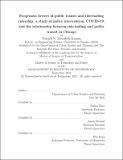| dc.contributor.advisor | Zhao, Jinhua | |
| dc.contributor.advisor | Stewart, Anson | |
| dc.contributor.advisor | Kong, Hui | |
| dc.contributor.author | Meredith-Karam, Patrick S. | |
| dc.date.accessioned | 2022-02-07T15:24:32Z | |
| dc.date.available | 2022-02-07T15:24:32Z | |
| dc.date.issued | 2021-09 | |
| dc.date.submitted | 2021-12-06T19:35:15.767Z | |
| dc.identifier.uri | https://hdl.handle.net/1721.1/140108 | |
| dc.description.abstract | Public transit is a crucial component of the urban mobility system for many cities, but several recent shocks have threatened its continued function. Additionally, Transportation Network Companies (TNCs) have grown rapidly in recent years, expanding travel choices for some but posing a challenge to public transportation, prompting the City of Chicago to price and regulate TNC services. The backdrop of the COVID-19 pandemic has posed further shocks to both travel modes and their riders. In response to these changes, this thesis asks the question of “How have public transit and TNC riders responded to various external factors, including a direct policy intervention, a public health emergency, and emerging mobility services, and what lessons can be extracted for policymakers and transit system operators?”
Through Chicago-based case studies of the questions above, this thesis examines the impacts of these shocks to urban mobility and extracts relevant takeaways for policymakers and transit agencies. The studies find that policy interventions may not cause anticipated changes to travel behavior, and that the policy impacts may differ substantially across space. These case studies provide examples that policymakers can use to evaluate program impacts to inform future policy adjustments. Regression analysis and survey findings highlight the importance of public transit to move essential workers during the COVID-19 pandemic and identify core ridership among bus riders and minority populations. This thesis also demonstrates the role of TNC services as acting significantly in competition with public transit, but found that the relationship became less competitive during COVID-19.
Chicago’s mobility landscape has undergone transformative change in recent years, and the future of the urban transportation system is uncertain as we recover from COVID-19. In the establishment of a post-pandemic normal, transit agencies and policymakers will need to continually evaluate the intended and unintended consequences of policy interventions, understand the behaviors and intentions of their riders, and assess their relationship with other modes of transportation. This thesis identifies analysis processes and provides practical examples for performing all these functions. | |
| dc.publisher | Massachusetts Institute of Technology | |
| dc.rights | In Copyright - Educational Use Permitted | |
| dc.rights | Copyright MIT | |
| dc.rights.uri | http://rightsstatements.org/page/InC-EDU/1.0/ | |
| dc.title | Exogenous drivers of public transit and ride-hailing ridership: a study of policy intervention, COVID-19, and the relationship between ride-hailing and public transit in Chicago | |
| dc.type | Thesis | |
| dc.description.degree | S.M. | |
| dc.description.degree | S.M. | |
| dc.contributor.department | Massachusetts Institute of Technology. Institute for Data, Systems, and Society | |
| dc.contributor.department | Massachusetts Institute of Technology. Department of Urban Studies and Planning | |
| dc.identifier.orcid | https://orcid.org/0000-0001-6245-3257 | |
| mit.thesis.degree | Master | |
| thesis.degree.name | Master of Science in Transportation | |
| thesis.degree.name | Master of Science in Technology and Policy | |
